To see through. How to study subjects without breaking them?
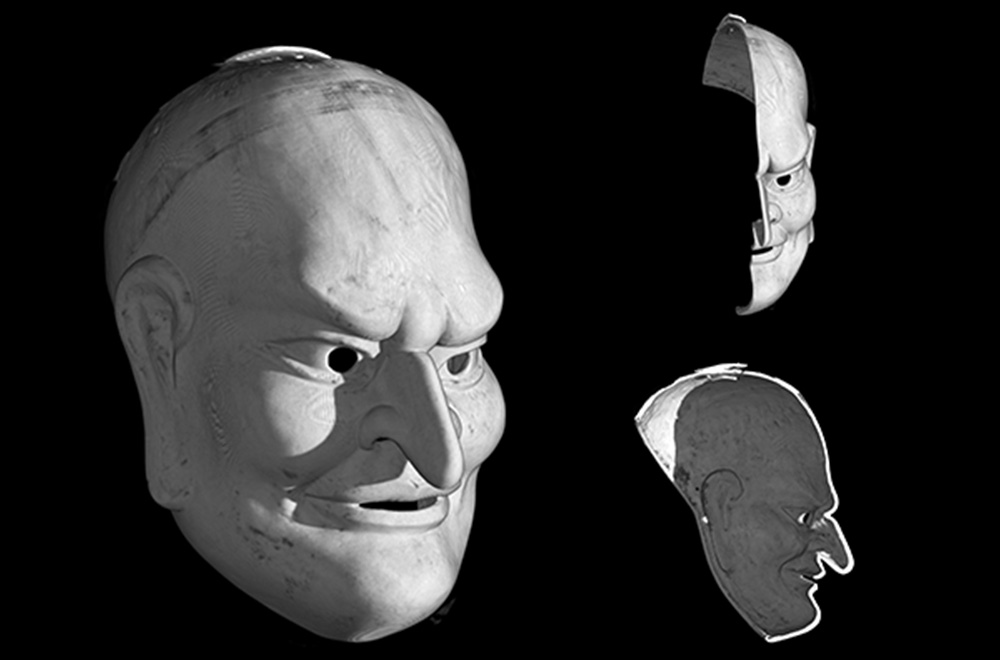
For almost five thousand years, mankind studied its products using only the senses: blacksmiths listened to the ring of Damascus steel, the architects of the Great Pyramids touched the smoothness of the blocks. We did not know how to investigate man-made objects without disassembling or breaking them until the 19th century, until the history of non-destructive testing technology (Nondestructive Inspection, NDI) began.
The story of non-destructive testing began, of course, with destruction.
In 1854, a completely new steam boiler exploded at a factory in Hartford, Connecticut. The explosion destroyed the workshop and took 21 lives. In the era of steam engines, boilers burst often, although they were produced with a huge margin of safety. The existence of microcracks and metal fatigue engineers could only vaguely guess. The explosion in Hartford for the first time forced the authorities to establish a regular commission, which was supposed to inspect steam boilers. It was then that engineers around the world thought about how to get inside what cannot be removed and disassembled.
')
The subsequent scientific and technological revolution by the middle of the 20th century armed us with a whole arsenal of non-destructive research methods designed to prevent and prevent a wide variety of misfortunes. Such techniques include x-ray, magnetic resonance imaging (MRI), electromagnetic radiation, computed tomography, and even cosmic rays. Much is known about the application of these technologies in medicine, safety and at work, so we decided to talk about the most non-trivial tasks that NDI helps us and our colleagues in other areas.
1. How x-ray helps 3D printing
If we can “enlighten” any object, then why not capture its three-dimensional model, and then make a copy of it? Toshiba IT & Control Systems Corporation (ITC) engineers have created the most accurate x-ray that can deliver ready-made 3D models in HD quality for 3D printing - the TX Lamino machine. It got its name from laminating, a technology of layer-by-layer X-ray examination of objects, which is its basis.
The TX Lamino shines through an object from different viewing angles, which helps to see details or defects that cannot be detected by viewing the 2D image. The machine is equipped with a nanofocus X-ray generator, that is, it can focus the rays at an optical point with a diameter of less than 1 μm, or more precisely, in the case of the TX Lamino, 0.25 μm. This allows to investigate very small items in detail. The 4-megapixel camera helps the nanofocus, which produces four times more clear images than conventional X-rays with a 1-megapixel camera.
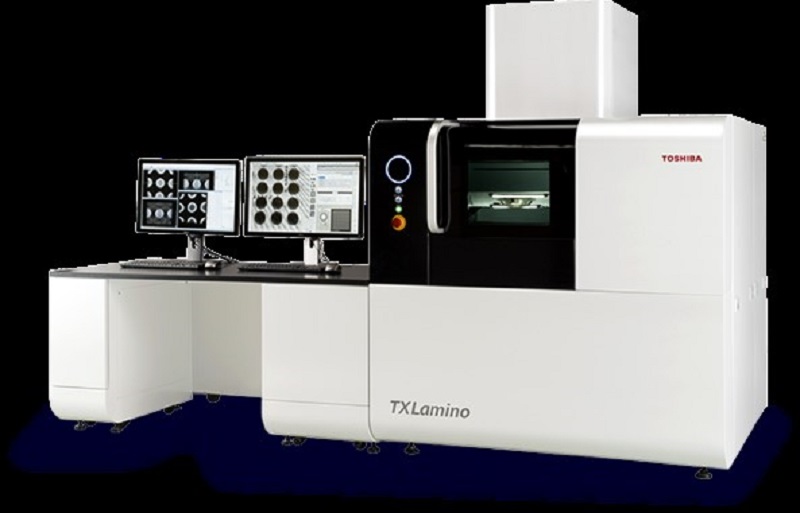 TX Lamino machine. With it, you can create an accurate 3D model of any object. Source: Toshiba ITC
TX Lamino machine. With it, you can create an accurate 3D model of any object. Source: Toshiba ITC X-ray takes layered images of the subject, and then combines them into a realistic 3D model that can be viewed on a monitor in 4K resolution. Moreover, if necessary, any of the photo layers can be studied separately from the others in 2D. For example, you can “decompose” the clam shell into layers.
Source: Toshiba News and Highlights YouTube Channel
Then the model can be turned into a real object on a 3D printer, and its internal structure will be absolutely identical to the original, even if we are talking about, say, engine parts with moving parts. For example, with the help of TX Lamino we managed to create a polymer copy of a ball bearing with a rotating ring.
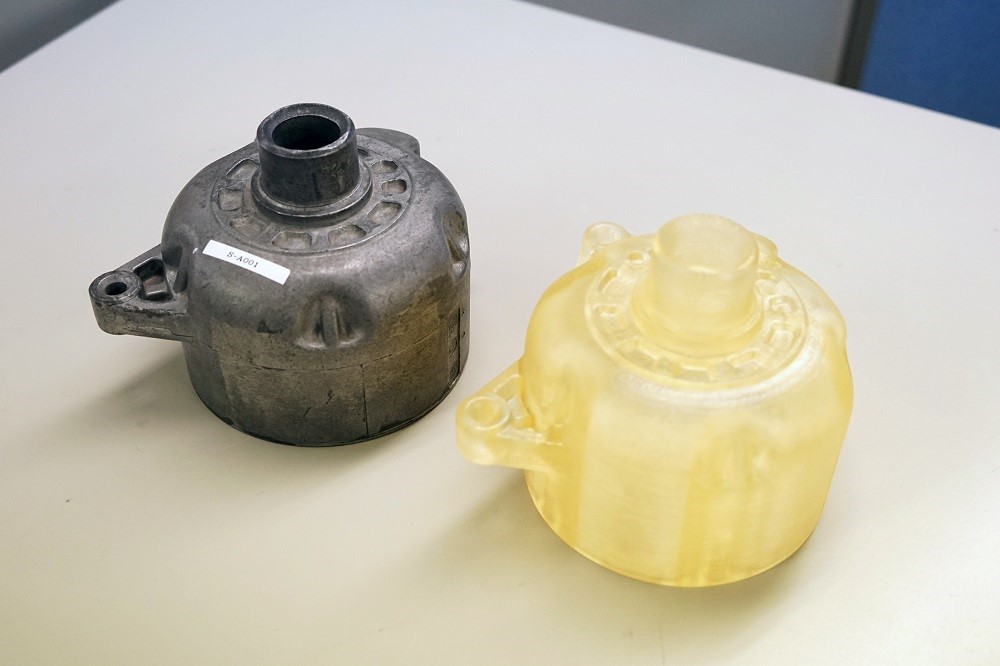
3D printout of engine parts made with TX Lamino. Source: Toshiba
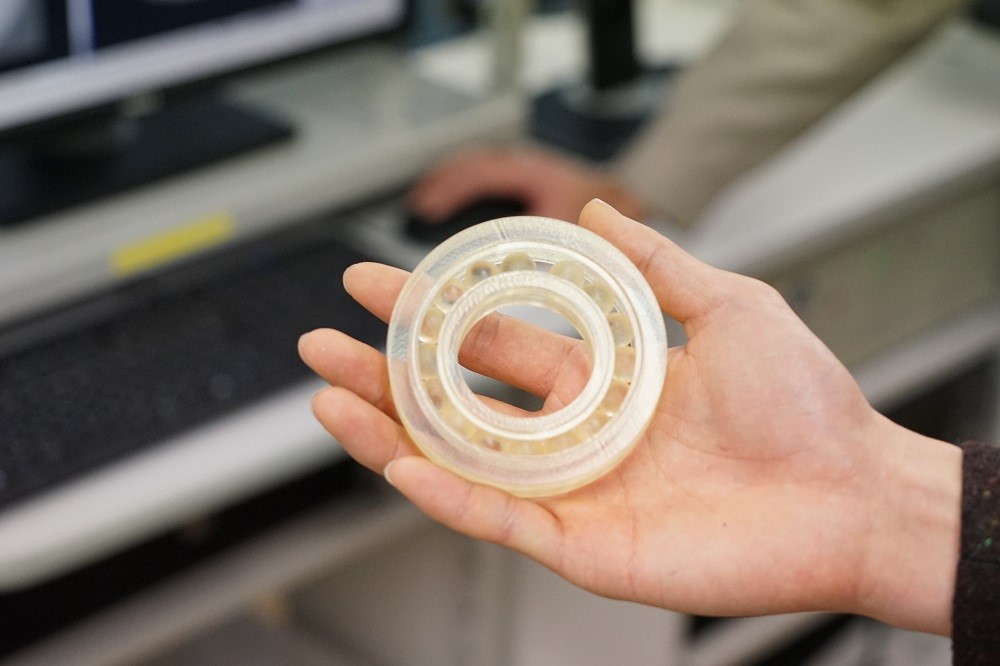
And the same bearing. Source: Toshiba ITC
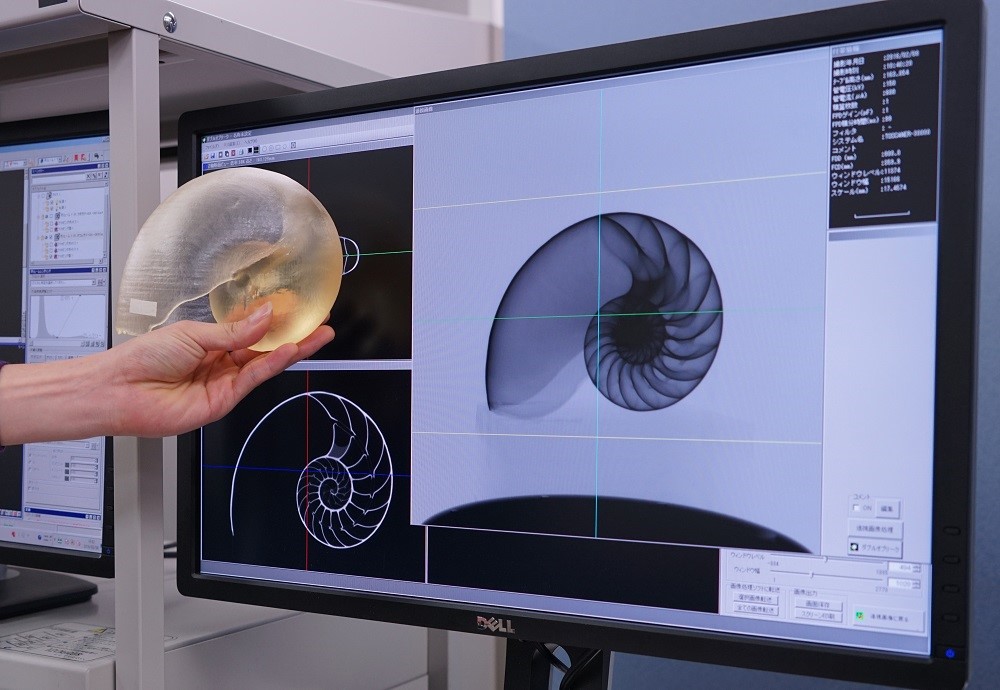
And that same clam shell. Source: Toshiba
The technology that allows you to literally see through any object helps us at Toshiba to cope with less original tasks, in particular, with quality control. Take, for example, cars. Any defect in important components and mechanisms creates a risk to human life and health. And not all defects we see with the naked eye. Our industrial systems, combining x-ray and advanced imaging technology, allow us to identify these problems.
Any metal blank seems at first glance completely solid. In fact, it is not. In the defective parts can be myriads of air bubbles, which over time will lead to breakage. You can see them only "under the gun" X-ray.

Aluminum car detail. On the left, an X-ray image showing clusters of air cavities and their size, differentiated by color. On the right is a 3D model. Source: Toshiba
However, as long as the 3D scanner is beyond the power of living creatures, a seashell or an aluminum block can shine through as many as you like, and living organisms, especially those that cannot be opened without breaking, once and for all, insects, for example, from frequent and / or intense exposure. spoil.
2. How to save the life of fruit flies
Insects with NDI technology have a complex relationship. It is almost impossible to get a clear three-dimensional image of a fly: the insect is constantly moving, and for a high-quality image you need complete peace of mind. In addition, invertebrates hardly tolerate large doses of radiation, and for a good 3D image, many shots are needed, so this photo session becomes deadly for insects. And even if the photo model survives the shooting, the exposure will negatively affect its growth, reproduction and life expectancy, which prevents long-term studies.
Our colleagues at the University of Western Ontario in Canada have solved this problem with carbon dioxide. The fact is that insects have the ability to survive with oxygen starvation. Their natural reaction to the lack of oxygen is a dream, during which the invertebrate remains immovable for some time.
Taking this into account, the following NDI method was developed: photo models are conveniently placed in a small, round-shaped chamber on a polystyrene backing. It is installed under the x-ray source. Then CO2 is supplied to the insect chamber, which puts them in a state of sleep.
At this point, the computed tomography (CT) starts to work, similar to those used to scan people. The main difficulty at this stage was the CT settings. Scientists always go for the inevitable compromise: the lower the radiation dose, the worse the quality of the image, and vice versa. Canadian scientists have concluded that to obtain good 3D images of sleeping insects, radiation is enough that is 80 times weaker than what sterilizes them. As it turned out, adult flies, Colorado beetles, caterpillars completely coped with a 7-hour stress test for hypoxia and irradiation, after which they quickly recovered.

Three-dimensional computed tomography (resolution - 20 microns) of the male moth. On the left - the first photo session, on the right - in four days. He is alive, though tired. Source: BioMed Central Ltd
However, absolute peace does not always guarantee the success of NDI, especially if we are not interested in the structure of the research subject, but, for example, the inscriptions in it.
3. How to read books using NDI
Perhaps the dream of all students will soon come true - to receive information from a closed book without clairvoyance. For this, a group of scientists from MIT called for help quite real forces of electromagnetism and terahertz radiation (average between infrared and microwave). Terahertz waves are well known to safety specialists: various chemicals absorb specific frequencies of TG radiation in different ways.
When TG rays pass through ink and clean paper, the sensory receiver receives a different intensity imprint — this is the way to read books or scrolls without unwrapping them — very useful when the sheets stick together and / or become very fragile, which often happens with old-fashioned publications which require access by researchers. The process is organized as follows: the TG emitter generates ultrashort radiation pulses on the book, and the camera's built-in sensor reads their reflection from tiny air pockets 20 microns wide between the pages of the book. The response from the letters and blank pages looks different, allowing you to discern the inscription.
Source: MIT Media Lab YouTube Channel
But not everything is so simple. Most of the radiation is either reflected or absorbed by the book, while other particles bounce not from air bubbles, but from other pages, creating a false signal. To separate the false signals from the true ones, you need to know the distance from the receiver to a specific page of the book. Now the algorithm developed by scientists can theoretically distinguish written at a depth of up to 20 pages. But in practice, approximately at a depth of nine pages, the energy of the reflected signal becomes so small that it is already impossible to distinguish it from noise. So while we can read, rather, newspapers, not books, although research continues. In addition, for NDI there are tasks from the era of pre-writing history.
4. Did the Neanderthal play the flute?
In addition to medical issues, the invention of Wilhelm Roentgen helps to solve historical problems. For example: could Neanderthals play flute?
The scientists thought that the cave bear's bone found in the cave of Divje Baba (Slovenia) was found. Two holes have been made in it, and the outlines of two more are visible on the scrapping sites. Together they form a row, like a flute. The age of the find is 43 thousand years, so some scientists believe that we have found a Neanderthal item, while others see hyenas feasting in the bone, whose fangs could make such neat holes.
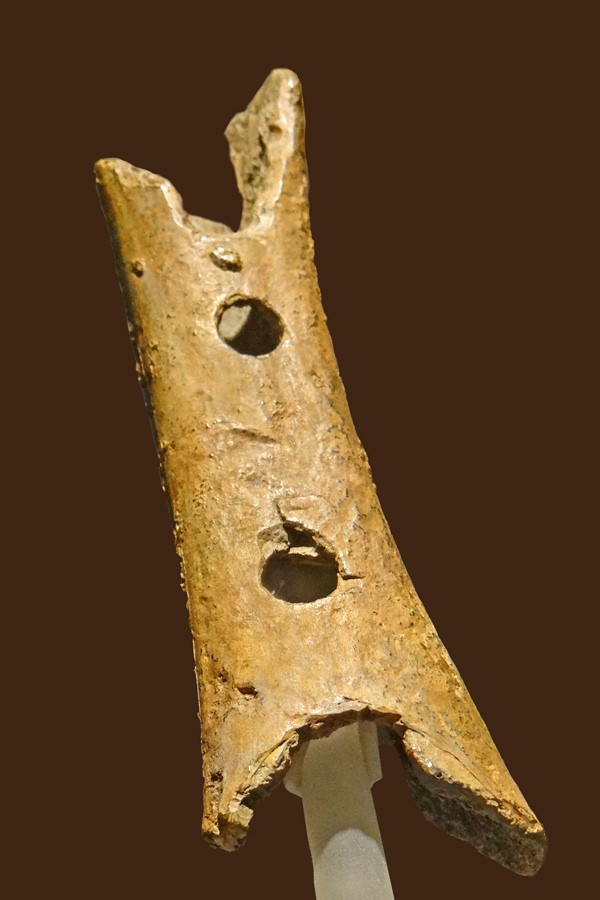
"Neanderthal flute" from Divye-Babe. The author of the holes is either a Neanderthal or a cave hyena. Source: Sporti / Wikimedia Commons
In order to thoroughly examine the "flute", scientists used computed tomography (CT): X-rays illuminated the bone from different angles, and the computer combined the images into a three-dimensional image. It turned out that there are indeed many traces of animal eating on the bones, but not all can be clearly attributed to the effects of the jaws. Then, using the obtained images, scientists reconstructed a copy of the "flute".
As it turned out, you can really play on it: the instrument produces up to 2.5 octaves in the sequence of melodies on a 12-tone scale. “Neanderthal flute” by virtue of legato, staccato, frullato, glissando and other methods of performance.
It is not so difficult to enlighten a small flute with X-rays, but there are more historical monuments. Much more. How to deal with them?
5. From heaven to earth: how cosmic rays helped make the "X-ray" of the pyramid
Almost all of our all-seeing technologies remain “myopic”: the “vision” of radars, X-ray units, ultrasound does not extend beyond (deeper) a few meters. And you need more! Approximately with such thoughts in 2016, a group of Japanese scientists from Nagoya University looked at the pyramid of Cheops with a volume of 2.5 million cubic meters. They decided to scan this object with cosmic rays, which are born from high-energy sources, say, supernova explosions. Passing through the atmosphere of the Earth, cosmic rays turn into secondary particles - muons. They have a very high penetrating ability: it is not a problem for them to overcome even 1 kilometer of limestone blocks.
Matter absorbs more muons than void. In order to "catch" the particles, the Japanese set up special traps inside the famous pyramid chambers. Bright muon prints indicated a previously unknown cavity above the Great Gallery of the Great Pyramid of Cheops. The space of 30 meters in length resembles the Great Gallery. As Egyptologists suggest, cosmic rays helped to detect the technical room - the cavity reduces the pressure of the blocks on the arches of the Grand Gallery.
By the way, the same technology is now used by Russian scientists in Derbent: they are trying to understand whether there was a cruciform structure completely hidden under the ground, the oldest Christian church in Russia or just a reservoir.
Source: Euronews
What will happen next?
We believe that in the near future, non-destructive testing technologies will be combined with other advanced developments:
- Big Data will help us collect and interpret much more information than a living radiologist can absorb;
- neural networks will make NDI more proactive: we will be able to build a system of mass testing of products, parts, components at the production stage, which does not require a direct human assessment;
- the immediate result of these operations will be implemented automatically using 3D printing . The processed results of the analysis will serve as “food” for 3D printers, which will immediately eliminate the shortcomings or improve the product in the conveyor mode.
Source: https://habr.com/ru/post/448326/
All Articles